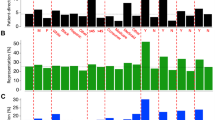Abstract
Objectives
To characterize unidentified patients presenting to a single, urban emergency department (ED) in Canada. We report their demographics, ED course, post-ED discharge outcomes, and mode of identification.
Methods
We performed a retrospective chart review using descriptive analyses to assess unidentified patients admitted to Royal University Hospital and St. Paul's Hospital EDs between May 1, 2018, and April 30, 2019, in Saskatoon, Saskatchewan, Canada. We assessed demographic data, clinical presentation, mode of identification, discharge information, and major clinical outcomes.
Results
Unidentified patients were disproportionately male (64.9%), and mostly presented as Canadian Triage and Acuity Scale (CTAS) 1 (41.6%) and CTAS 2 (44.2%). Most patients arrived via emergency medical services (80.7%). The most common presenting complaints were substance misuse (33.3%) and trauma (24.6%). The average ED length of stay was 8.7 h (SD 18.6). Many patients received an inpatient consult (58.8%), and 22.3% received support services (e.g., social work). The 30-day mortality of all patients was 13.2%. Of those patients who survived to ED discharge, common dispositions included: home (36.0%), police services (3.5%), or emergency shelters (3.5%). Four (3.5%) patients returned to the hospital unidentified within the study period, and 6.7% of patients discharged from the ED returned within 48 hours.
Conclusion
Unidentified patients are a high-needs demographic that present mostly with substance misuse or trauma. Repeat ED attendance, sometimes as unidentified patients again, calls for initiatives that facilitate prompt identification, better discharge planning, and linkage to social supports.
Résumé
Objectifs
Caractériser les patients non identifiés se présentant à un seul service d’urgence urbain au Canada. Nous rapportons leurs données démographiques, leur parcours aux urgences, leurs résultats après leur sortie de l’urgence et leur mode d'identification.
Méthodes
Nous avons effectué un examen rétrospectif des dossiers à l’aide d’analyses descriptives pour évaluer les patients non identifiés admis à Royal University l’hôpital et St. Paul's Hospital aux urgences de l’hôpital entre le 1er mai 2018 et le 30 avril 2019, Saskatoon, Saskatchewan, au Canada. Nous avons évalué les données démographiques, la présentation clinique, le mode d'identification, les informations de sortie et les principaux résultats cliniques.
Résultats
Les patients non identifiés étaient en grande partie des hommes (64.9 %) et se présentaient principalement sous la forme d'une échelle canadienne de triage et de gravité (ÉTG) 1 (41.6 %) et ÉTG 2 (44.2 %). La plupart des patients sont arrivés via les services médicaux d’urgence (80.7 %). Les plaintes les plus courantes étaient l'abus de substances (33.3 %) et le traumatisme (24.6 %). La durée moyenne du séjour à l’urgence était de 8,7 heures (écart-type : 18.6). De nombreux patients ont reçu une consultation interne (58.8 %) et 22.3 % ont reçu des services de soutien (p. ex., travail social). La mortalité sur 30 jours de tous les patients était de 13.2 %. Parmi les patients qui ont survécu à la sortie du service d'urgence, les dispositions courantes comprenaient : domicile (36.0 %), services de police (3.5 %) ou refuges d'urgence (3.5 %). Quatre (3.5 %) patients sont retournés à l'hôpital sans être identifiés pendant la période d'étude, et 6.7 % des patients sortis des urgences sont revenus dans les 48 heures.
Conclusion
Les patients non identifiés constituent un groupe démographique à besoins élevés qui se présente principalement avec un abus de substances ou de traumatisme. La fréquentation répétée des urgences, parfois en tant que patients non identifiés à nouveau, nécessite des initiatives qui facilitent une identification rapide, une meilleure planification de la sortie et la mise en relation avec des soutiens sociaux.
Similar content being viewed by others
References
Janowak CF, Dolejs S, Zarzaur BL. Who is John Doe? A case-match analysis. Am Surg. 2017;83(8):E294.
Bell SM, Sokhi D, Hughes T, Randall MS. Treatment of the unknown patient: insights from acute stroke. Pract Neurol. 2017;17:453–5.
Campanella P, Lovato E, Marone C, Fallacara L, Mancuso A, Ricciardi W, Specchia ML. The impact of electronic health records on healthcare quality: a systematic review and meta-analysis. Eur J Public Health. 2016;26(1):60–4. https://doi.org/10.1093/eurpub/ckv122 (Epub 2015 Jun 30 PMID: 26136462).
Mullins A, O’Donnell R, Mousa M, et al. Health outcomes and healthcare efficiencies associated with the use of electronic health records in hospital emergency departments: a systematic review. J Med Syst. 2020;44:200. https://doi.org/10.1007/s10916-020-01660-0.
Cuomo A, Zucker H, Dreslin S (2017) Identification of unidentified patients: Model policy. Albany: New York State Division of Criminal Justice Services. https://www.criminaljustice.ny.gov/missing/docs/DHDTC-DAL-17-03-Identification-of-Unidentified-Pts-with-Policy.pdf
City of Saskatoon. Population growth and rate of change [Internet]. Saskatoon, SK; City of Saskatoon (2019). Accesed 26 March 2020. https://www.Blinded.ca/city-hall/our-performance/performance-dashboard/sustainable-growth/population-growth-and-rate-change
Claps PJ, Berk WA. The John Doe syndrome: [diagnosis and outcome of patients unidentified at the time of emergency department admission. Am J Emerg Med. 1992;10(3):217–8.
Kim JJ, Kwok ES, Cook OG, Calder LA. Characterizing highly frequent users of a large Canadian urban emergency department. West J Emerg Med. 2018;19(6):926.
Canadian Emergency Department Information System (CEDIS), (2012). pp.1-2. Available at: https://caep.ca/wp-content/uploads/2016/03/nacrs_presenting_complaint_list_v2_0_en_fr_pdf_pdf.pdf. Accessed 20 March 2020.
Acknowledgements
The authors express their sincere thanks to Ha Le (Clinical Research Support Unit), Rhonda Bryce (Clinical Research Support Unit), Aimee Goss (Health Record Services), Marissa Alarcon (Clinical Research Support Unit, Health Research Quality Improvement), and Sheree Tesch (Strategic Health Information and Performance Support) for their support and assistance over the course of this study during data collection and analysis.
Funding
This project was funded by the University of Saskatchewan College of Medicine through the Dean’s Summer Research Projects initiative.
Author information
Authors and Affiliations
Corresponding author
Electronic supplementary material
Below is the link to the electronic supplementary material.
Rights and permissions
About this article
Cite this article
Tastad, K., Koh, J., Goodridge, D. et al. Unidentified patients in the emergency department: a historical cohort study. Can J Emerg Med 23, 772–777 (2021). https://doi.org/10.1007/s43678-021-00165-0
Received:
Accepted:
Published:
Issue Date:
DOI: https://doi.org/10.1007/s43678-021-00165-0




